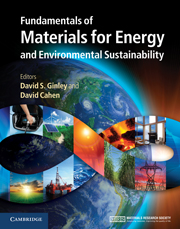Book contents
- Frontmatter
- Contents
- Contributors
- Preface
- Acknowledgments
- Part 1 Energy and the environment: the global landscape
- Part 2 Nonrenewable energy sources
- Part 3 Renewable energy sources
- 17 Solar energy overview
- 18 Direct solar energy conversion with photovoltaic devices
- 19 Future concepts for photovoltaic energy conversion
- 20 Concentrating and multijunction photovoltaics
- 21 Concentrating solar thermal power
- 22 Solar thermoelectrics: direct solar thermal energy conversion
- 23 Off-grid solar in the developing world
- 24 Principles of photosynthesis
- 25 Biofuels and biomaterials from microbes
- 26 Biofuels from cellulosic biomass via aqueous processing
- 27 Artificial photosynthesis for solar energy conversion
- 28 Engineering natural photosynthesis
- 29 Geothermal and ocean energy
- 30 Wind energy
- Part 4 Transportation
- Part 5 Energy efficiency
- Part 6 Energy storage, high-penetration renewables, and grid stabilization
- Summary
- Appendix A Thermodynamics
- Appendix B Electrochemistry
- Appendix C Units
- Index
- References
18 - Direct solar energy conversion with photovoltaic devices
from Part 3 - Renewable energy sources
Published online by Cambridge University Press: 05 June 2012
- Frontmatter
- Contents
- Contributors
- Preface
- Acknowledgments
- Part 1 Energy and the environment: the global landscape
- Part 2 Nonrenewable energy sources
- Part 3 Renewable energy sources
- 17 Solar energy overview
- 18 Direct solar energy conversion with photovoltaic devices
- 19 Future concepts for photovoltaic energy conversion
- 20 Concentrating and multijunction photovoltaics
- 21 Concentrating solar thermal power
- 22 Solar thermoelectrics: direct solar thermal energy conversion
- 23 Off-grid solar in the developing world
- 24 Principles of photosynthesis
- 25 Biofuels and biomaterials from microbes
- 26 Biofuels from cellulosic biomass via aqueous processing
- 27 Artificial photosynthesis for solar energy conversion
- 28 Engineering natural photosynthesis
- 29 Geothermal and ocean energy
- 30 Wind energy
- Part 4 Transportation
- Part 5 Energy efficiency
- Part 6 Energy storage, high-penetration renewables, and grid stabilization
- Summary
- Appendix A Thermodynamics
- Appendix B Electrochemistry
- Appendix C Units
- Index
- References
Summary
Focus
During the last decade the direct conversion of solar energy to electricity by photovoltaic cells has emerged from a pilot technology to one that produced 11 GWp of electricity generating capacity in 2009. With production growing at 50%–70% a year (at least until 2009) photovoltaics (PV) is becoming an important contributor to the next generation of renewable green power production. The question is that of how we can move to the terawatt ( TW ) scale [1].
Synopsis
The rapid evolution of PV as an alternative means of energy generation is bringing it closer to the point where it can make a significant contribution to challenges posed by the rapid growth of worldwide energy demand and the associated environmental issues. Together with the main existing technology, which is based on silicon (Si), the growth of the field is intertwined with the development of new materials and fabrication approaches. The PV industry, which was, until recently, based primarily on crystalline, polycrystalline, and amorphous Si, grew at an average annual rate of 50% during 2000–2010. This rate was increasing, at least until the 2008 economic crisis, with production of ~11 gigawatts (GWp) per year in 2009 [2]. While this may seem a very large number, PV installations in total are still supplying only <0.03% of all the world's power needs (~14–15 TW) [2]. As production increases, increasing individual cell efficiency and translating that to modules, as well as reducing manufacturing expenses and increasing system lifetimes, are all critical to achieving grid parity, the point at which the cost of PV power is equal to the price of grid electricity.
- Type
- Chapter
- Information
- Publisher: Cambridge University PressPrint publication year: 2011
References
- 1
- Cited by



